
Publisher:
Bonnie King
CONTACT:
Newsroom@Salem-news.com
Advertising:
Adsales@Salem-news.com

~Truth~
~Justice~
~Peace~
TJP
Mar-25-2024 06:26


 TweetFollow @OregonNews
TweetFollow @OregonNews
rewilding LA: Matilija Dam History and Ecosystems
Robert Lundahl special to Salem-News.comCreative FRONTLINE Interview with Tracker Ginamarie Rangel Quinone (Chiricahua Apache, AIM Grassroots)
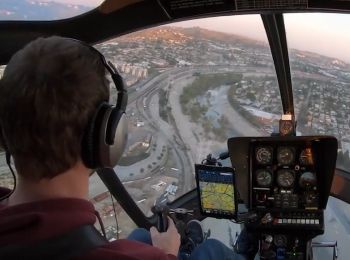 Helicopter view of the LA River Image credits: see below |
(LOS ANGELES, Calif.) -
Tracker Quinone |
Exclusive Interview with Tracker Quinone
Tracker Quinone: I got here a couple days ago. I was in Arizona, I arrived so that I could do a report on the Matilija Dam. Yesterday there was an alert for "flash flood" warnings so I went up there anyway, but there were road closures. I got through to the park where they had the flooding and there was a huge river in the canyon so there was no getting back there.However, today is a little better. It stopped raining a couple hours ago but today is 93% rain forecast and we'll probably have a over a half an inch of rain today. So we're looking at tonight, at least over a half an inch of rain again with high wind.
Robert Lundahl: Wow and so there you are in a natural system. You have rain falling into the land and into the river and going to the sea, so you're witnessing the natural process.
Tracker Quinone: Yes, and the reason why I wanted to go in yesterday is because they did draining behind the Matilija Dam and I know that there are a lot of things going on down at the bottom... things that have not been revealed or unearthed for many years.
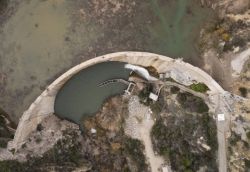 Matilija Dam, Ventura River, N. of Ojai, CA. |
So it's going to be important for us to go in there and do some investigation of what's there. Now that we've had the flooding and the river pushing everything, rock, debris and life and things that are down there.
It's filling up again behind the dam so we don't know how long we'll have to wait to see, you know if the water levels are going to go down so that we can go and do some investigation.
Robert Lundahl: So you're talking about what's been described as Cultural Resources, right?
Tracker Quinone: Yes, we're talking about a history of a massacre of The Last Stand of the Chumash People, and this took place in the 1800's.
The Last Stand is important for that area back there because they had come up against that area where the hot springs are, all the way to where the lake is and the dam is and that's where a lot of the Massacre had taken place.
I have done some research looking into that particular time in history to find out if there has been any other things written about that historical landmark and I can't find very much.
We're really interested in seeing what may be there at "Ground Zero" after the water has been drained.
Now, 15, 20 years ago, they did a feasibility study by the Army Corps of Engineers and recruited us at the Mesa Matilija Environmental Science Center to be part of a logistical force and task force to be able to go back there and help to identify native species, and also to help in the study of removing the dam.
Since then, I think in 2010 they did some detonating and explosions but after that it's just always been in funding and a retrospective ideology of what should happen.
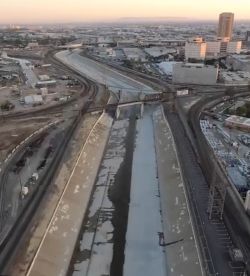
Six years ago, Candice Meneghin wrote a 170 million funding plan and a 3.3 million grant for the Matilija Dam ecosystem, and that was for a restoration program.
That was really motivating and inspiring because we are looking at a very sensitive ecosystem, and behind the dam up through the canyon there's at least four ecosystems.
I have witnessed myself the different Riparian Woodland, Wetland, and Dry Rock Bed ecosystems, and so they have recognized this as a very sensitive place that hosts a variety of animals and very sensitive place for the ecosystem to grow and thrive.
However at the same time, 20 years ago, Monsanto went back there and was spraying Glyphosate, and they were doing eradication of non-native species so we had to do a lot of propagation of the natural natives like the Willow and other plants and trees so that we can save those and the medicines back there.
There's an array of medicines and root systems, so foraging and gathering is very prevalent to the native people. We had to realize that they were spraying and over spraying a lot of the medicine, so that caused a lot of controversy.
That's why Patty Pagaling created Pesticide-Free Ojai and stopped the spraying. Since then, it has gained a lot of momentum, and she is still active, and that's who we're going to be doing the reporting with.
She still lives back there. There's many people that do live back there. Some people have gotten sick so there's a lot of controversy on that spraying and this funding the dam removal, the two bridge replacements and three levels of upgrades.
I should say new operations for the Robles diversion, and Santa Ana Bridge, so other elements are in play. She attended a program update in December and they're doing a 100% design and they supplement on that, so when that comes out she's doing her planning and they're doing that supportive ecosystem restoration.
Ventura County, on the other hand, is just seeing dam removal and, you know, removing of it, so that as we talked about the spawning of the salmon and things like that can happen, the life force that lives there, that thrives, can go back to its natural habitat.
At this time it would be a disruption for them to do a fish hatchery there. It would just disrupt the whole ecosystem and the natural habitat.
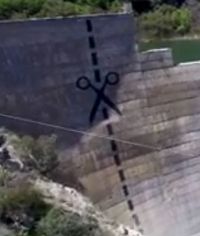 Scissors painted on Matilija Dam |
Robert Lundahl: Yes, so in other words, if they were going to have a hatchery to help restore the fish stocks it wouldn't be there– I mean, you could release the fish there so that they imprint on the water and they return there but the Hatchery itself doesn't have to be at that location.
Tracker Quinone: Yes, and of course you know when the dam is removed, what happens is it connects to other fingers of tributaries, lakes, creeks and so that's going to create another vein of waterways for the LA River.
I think the vision would be to create a plan or a steering committee for a planning of all of the restoration of natural habitat to connect all of the river systems.
Robert Lundahl: Yes, that's a vision to look at- what the river once was and to not compromise by saying, we're going to let these stocks go extinct. Can you talk about that a little bit?
What are your feelings about it and what might a tribal perspective be or the Chumash perspective?
I mean not specifically with regard to the species or science, but what does a restored ecosystem provide for the people? What does it look like?
Tracker Quinone: I am not Chumash, I am Chiricahua Apache, and I have worked in the lands of the Chumash territory, the Coastal Band and also behind Matilija in the Matilija Environmental Science Center.
I have seen an array of designs and what you can call planning for different waterways, fisheries, hatcheries but I think for a natural ecosystem at this point in time in history, of course, we can't go back and restore anything to its natural state, we can only support, introduce, and be able to encourage growth, spawning, and natural habitat.
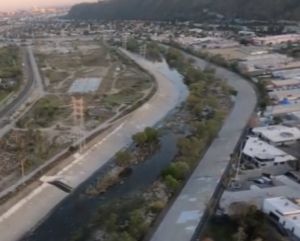 Flying above the LA River |
At this time I do know the story of the spectacular Steelhead trout that used to swim in the Los Angeles River, for instance, and of the current efforts to restore conditions for the Steelhead there.
The LA River passage and habitat structure design project is now under way, which I encourage everyone to support in any way they can, and that includes being stewards of the Arroyo Seco.
They're putting Steelhead and the LA River agenda first and foremost and they're recovering the Steelhead populations in the LA River Watershed.
Now that's sounds all pretty and nice but you just can't put things back without also looking at the native species, plants and what has been done.
Also, when I have seen the co-existence and the bio-regions of natural native plants and species co-habitate, and when the ecosystems are disturbed because of dams and pollution then we see a lot of things happen where there becomes a lot of problems, especially with pollution in the waterways.
So, as they say "what happens upstream comes downstream" and we really need to look at the Watershed. We also need to look at what is the ecosystem at this time, because we can't go back in time and restore it to what it was naturally.
It's not going to be that way; we have to work with the native plant species that are going to actually create that photosynthesis, the natural bio rhythms of the waterways, which will support the life and habitat of the natural ecosystem of the fishery and the plants and the animals and things that come there.
I think that we have to look at, for myself and other Native peoples, we're looking at not only restoring the fishery, original fish, to be able to have a supportive habitat, but we're looking at the plants and the ecosystem, and the whole natural biorhythms of all of that together.
And I think that when we try to put dams up or when they have tried to put things in place to stop water or make water move in the direction they want they've seen that creates problems as we say downstream.
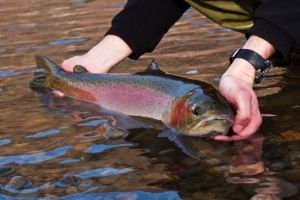 Steelhead Trout (Michael Humling/USFWS) |
It's really important that they do consult with Native tribal land people and also there are tribal Coastal bands that have been working symbiotically with the wetlands, with the riparian lands, with the woodlands.
We know that it all is in relationship and you can't change that. You can try to, but we know that you can't change it. It all has a relationship together.
Robert Lundahl: Thank you. That's really insightful for people who have little experience or have not thought this through in any meaningful way.
So I know you're not going to speak for the Chumash people, but in your view and experience, do they identify as "salmon people?"
Tracker Quinone: Yes they do. They have different bands and the Coastal Bands do. They are people who take a lot of Honor in the medicine and the waterways and the life forces that are there.
I know that they have yet to be consulted really, with the Army Corps of Engineers and the political arena of what should happen at the dam and what could happen, but I do encourage them to look at the history back there.
Look at that, and take the appropriate measures so that it could be they're able to look at what the history is and how they can honor that history and then move on and be a part of the decision making regarding what's going to happen there in that area.
You have a rock quarry across the way that has been there for 30 to 40 years and that quarry is an important crucial aspect of this dam, which is just across the road.
All this quarrying activity has created its own dam and the rock and the debris has for 40 years built up right there in that area, in the water area in the river as it flows. They have to have that vision of being able to look and see how this relationship is going to determine what's going to happen in the Waterway system.
The Matilija dam is only approximately 6 to 10 miles from the ocean,
so it's not far at all. It's going to be a very highly sensitive issue when it comes to directing what they want to do, actually, and how they want to create that water system to go to the ocean because a lot of damage has been done by damming up that area.
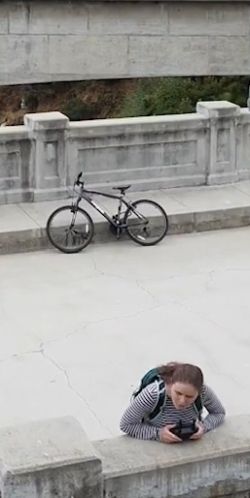
It reminds me of the construction of the Devil's Gate Dam in 1920, and the Steelhead could no longer reach the cold waters of the upper mountain watershed of the area to spawn, and the subsequent connection of the Arroyo Seco stream and the Los Angeles River made return basically impossible.
So if you look at it today, the iron gates (the Iron Gates are all the dams, all the way up North, all the way up to Washington) have created a lot of detrimental value to not only people personally in their life to get to fish for their families, but it also it devalued the whole ecosystem along the way, including animals who would go into the water and to fish for themselves, the natural way, and the spawning, of course, of the Steelhead.
So we know all this but you know it still happened.
Those dams went up and now we have to live with that and and course correct it. And I'm not the one that's going to make those decisions but I do believe that consulting the tribal people of the local tribe and First Nation people is so important.
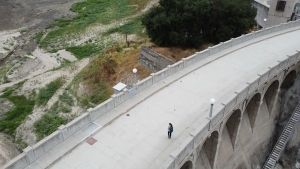 Devil's Gate |
Robert Lundahl: I grew up in Pasadena right by the Arroyo Seco, and there's a mandate in the State of California to teach the Native American history in third grade for all the kids.
No one told us about the Arroyo Seco and the inhabitation of the area or the the Devil's Gate Dam, and years and years later I wrote a piece called Rose Bowl Genocide.
It was published during the Rose Bowl game and a lot of people were very interested in reading this. The area was inhabited by the Xaxaamonga people who are a band of the, who we call Tongva who are Chumash relative, essentially, very close.
I was so surprised to find out this information- that there had been a massacre there at Arroyo Seco at the Devil's Gate Dam. That it was a sacred area and a village site. This information was suppressed from my education growing up.
Xaxaamonga Monga was the name of the Chief and the Tribe and the place. Do you have any thoughts on that? That's all from research and "book learning," you know but that's what I picked up, because I lived there, I grew up there that was my home, that was where my spirit lived when I was 5 years old, so I'm learning more about that.
Tracker Quinone: That's important, you know, those stories that you're talking about are oral stories that we value as first witness account. This is important, what you're speaking of, being able to have a relationship with the rivers. Today, that's not so, and so I do know that there has been a change– and since the dams and the Waterway systems and just even water rights.
Golden State (Water Company) came in to California and they had created contractual agreements for the water rights of California, especially Ventura County, and Ojai.
What happened was we saw a large volume of water being taken without the pipes being able to support it, so it created disaster, disaster, and emergencies after emergency. Those things are still in play and that damage is still being restored today from that volume of water being taken.
We need to look at that, like you say, of what used to be and the rivers and the waterways that we used to have access to, but no longer do.
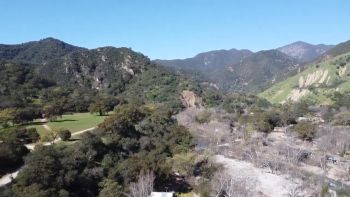 Arroya Seco |
We need to look at that perspective and say when is enough. Being able to have agricultural agreements and contracts to take that water and move it to a different county is fine but to move it to another country, I think is not okay.
It not only impacts the local waterways but it impacts the homeowners and all of the development that has to happen that is a big problem with our system, water that is moved in large volumes.
No one, 100 years later, thought that there would be hope that we can bring some of the trout and native fish back to the Los Angeles River.
Exploring fish passage, habitat structures, and how to design stream improvements will provide good habitat and conditions for Steelhead trout and other native fish in a 4.8 Mile Stretch of LA River near downtown LA, and create migration corridors in the more natural sections.
So you see, we have hope they are looking at natural corridors of water where the habitat is moving and growing and thriving naturally and to take a look at that before we just introduce all these trout.
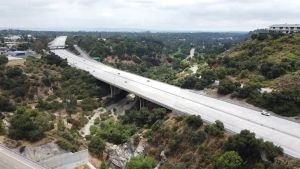 Arroya Seco |
We need to really see how the adaptation is going to be. It's like introducing an animal back into the wild or an eagle or a hawk back into the wild, you have to look at their predatory habitat and their practices, and their survival skills. Same with the plant, same with the fish, same with any animal.
The project objective is to enhance the native fish habitat linkages so the proposed construction will involve cutting and modifying the concrete channel that now lines the river to enhance habitat and migration corridors for native fish while maintaining flood management capacity.
So we are 100 years later, looking at different technology or construction, or ways to create pathways for the symbiotic relationship to happen naturally, which is important after all this time.
I see people and local support having a voice.
Robert Lundahl: Thank you, Tracker.
WATCH VIDEO:
[Note: Transcript Edited by Bonnie King, Salem-News.com for ease in readability.]
CREDITS:
- Helicopter view of the LA River: Van Nuys to Long Beach: Mican Muzio
- Steelhead trout; Credit: caltrout.org
- Matilija Dam drone view- Shot by: Contempt805 Edited by: Nowonshall
- Matilija Dam flyover (April 2021) by: Ventura County Public Works
- Ventura River Ecosystem: Matilija Reservoir Drained Ventura County Public Works
- Arroyo Seco (3/25/23) Drone Seco Adventures
- DJI Mavic Mini - Third drone flight - Devil's Gate, Lisanne Braat
SERIES ARTICLES:
- Oct-07-2023
A Story Told: Benefits or a Curse at Thacker Pass
http://www.salem-news.com/articles/october072023/fort_mcdermitt-lithium_america-rl.php - Sep-11-2023
Dorece Sam: SLAPP Suits and Dirty Deals
http://www.salem-news.com/articles/september112023/dorece-sam-slapp-suits-rl.php - Aug-14-2023
Chasing the American Dream in Lithium Valley
http://www.salem-news.com/articles/august142023/american-dream-lithium-valley-rl_.php - July 19, 2023
New Series on KPFK Features Voices of Land Defenders and Environmental Justice Advocates
http://www.salem-news.com/articles/july192023/creative-frontline-lundahl.php#video - Jun-28-2023
What Do We Mean by Environmental Justice? A Legacy of Greenaction
http://www.salem-news.com/articles/june282023/greenaction-environmental-justice-rl.php#video - Jun-03-2023
Thacker Pass, An Archaeological Perspective
http://www.salem-news.com/articles/june032023/thacker-pass-archaeological-rl.php#video - May-24-2023
The Fight to Save Thacker Pass
Peehee Muhu: Rotten Moon
http://www.salem-news.com/articles/may242023/will-falk-thacker-pass-rl.php#video - May-03-2023
Oak Flat: The Story Behind the Story
Mahlee Yellowfeather, Great Granddaughter of Geronimo
http://www.salem-news.com/articles/may032023/oak-flat-geronimo-rl.php#video - Apr-13-2023
The Land You Know Has Been Given to You
http://www.salem-news.com/articles/april132023/the_land_you_know-rl.php#video - "Who Are My People?" Television documentary by Robert Lundahl
https://www.youtube.com/watch?v=zWJMLYi0iGs
Articles for March 25, 2024 | Articles for March 26, 2024






Terms of Service | Privacy Policy
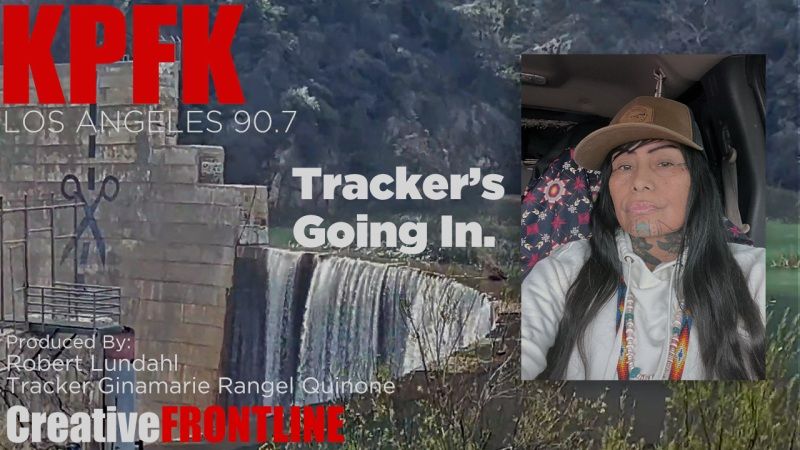
All comments and messages are approved by people and self promotional links or unacceptable comments are denied.
[Return to Top]
©2025 Salem-News.com. All opinions expressed in this article are those of the author and do not necessarily reflect those of Salem-News.com.